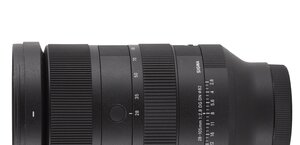Olympus M.Zuiko Digital ED 25 mm f/1.2 PRO
3. Build quality
In the photo below the tested lens is positioned next to two PRO zoom lenses, the Olympus 12-40 mm f/2.8 and the 12-100 mm f/4.0.
 |
Please Support UsIf you enjoy our reviews and articles, and you want us to continue our work please, support our website by donating through PayPal. The funds are going to be used for paying our editorial team, renting servers, and equipping our testing studio; only that way we will be able to continue providing you interesting content for free. |
- - - - - - - - - - - - - - - - - - - - - - - - - - - - - - - - - - - - - - - - - - - - - - - -
The M.Zuiko 25 mm f/1.2 PRO starts with a metal mount; it surrounds contacts and a rear element, 19 mm in diameter. The element seems to be immobile, with perfectly darkened edges and an area next to them. On the black part featuring contacts you find information that the lens was produced in Japan.
 |
The proper body, completely made of metal, starts with a ring which doesn’t move. If has a red dot, making an alignment with a camera easier. Under the dot there is the name and the parameters of the model and on the other side of the lens, opposite to the dot, you get information concerning the waterproof properties (SPLASH PROOF) and the focusing range (0.30m/0.98ft –∞). Further on there is another black, immobile ring made of metal with the function L-Fn button.
 |
Then you see a manual focus ring, as wide as 32 mm. Depending on its position it works in different modes. When you press the ring toward the front element you get a fly-by-wire focusing. When you move it toward the mount a distance scale is revealed and you engage the manual mode. Its performance is flawless – the ring moves smoothly and is well damped. Running through the whole range in the mechanical mode takes a turn through an angle of 100 degrees.
 |
Next, you get a part of the casing which doesn’t move, with the depth of field scale and marks by f/5.6, f/8.0, f/11 and f/16, the name and parameters of the lens and two narrow rings, blue and gray.
The front element is 43 mm in diameter and it doesn’t rotate during focusing. Around it you find a non-rotating filter thread, 62 mm in diameter, and a hood mount.
 |
When it comes to the optical construction you deal with optically the most complex fixed focus lens we’ve tested so far. It consists of as many as 19 elements positioned in 14 groups. The number of special elements is impressive as well – you get as many as three high refraction index (HR) elements, two made of low dispersion ED glass, one made of Super ED glass, one aspherical element and one with Extra High Refractive Index (E-HR). Inside you can also find an aperture with nine diaphragm blades which can be closed down to f/16.
 |
Buyers get both caps and a hood with the lens in the box.
 |






